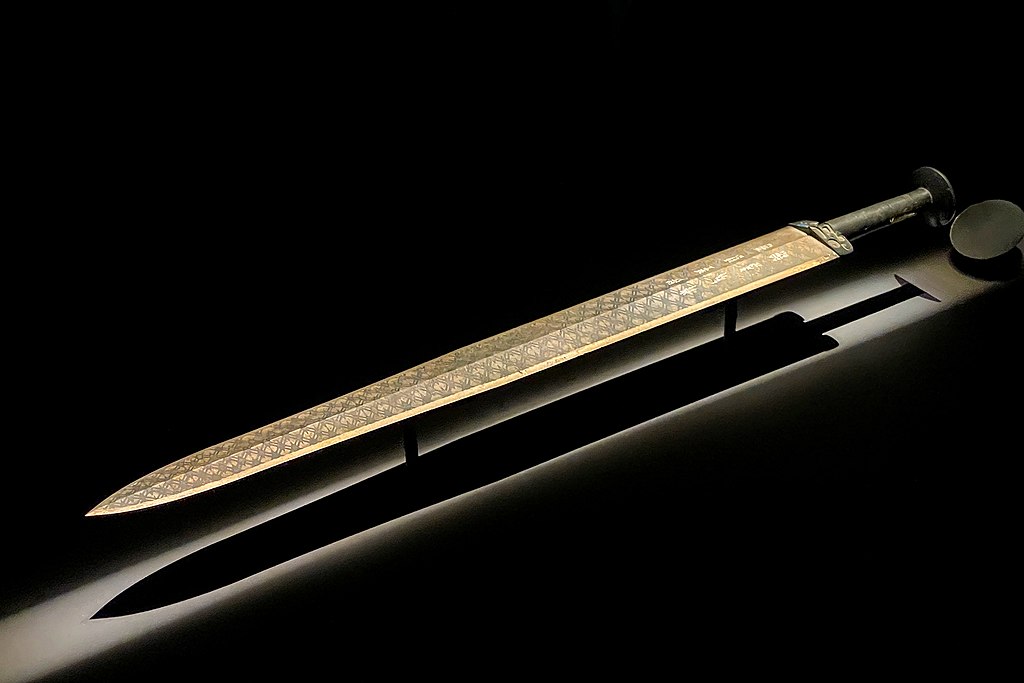The Yue King Goujian Sword, dating back to the Spring and Autumn period (771 to 476 BCE), stands as one of the most enigmatic and fascinating artifacts from ancient China. Discovered in 1965 in a tomb in Hubei Province, China, this sword has captivated historians, archaeologists, and enthusiasts alike due to its remarkable preservation, craftsmanship, and historical significance.

Discovery of a Perfectly Preserved Relic
When the sword was unearthed, it was astonishingly found in near-perfect condition. Despite being buried for over 2,000 years, the blade remained untarnished and incredibly sharp, a fact that continues to baffle experts. The tomb where it was found belonged to an unknown nobleman from the ancient state of Chu, but the sword itself is attributed to Goujian, the famous King of Yue. The preservation of the sword, particularly in the damp conditions of a tomb, suggests advanced techniques in metallurgy and preservation that were previously unknown for that time period.
Masterful Craftsmanship
The sword’s blade, made of bronze, is noted for its exceptional sharpness and durability, qualities that are often associated with more modern weapons. The high tin content in the bronze alloy contributes to its hardness, making it a formidable weapon in its time. Moreover, the sword is adorned with intricate designs, including patterns and inscriptions in the ancient Bird-worm seal script, which further attest to the skill of the craftsmen who created it. These inscriptions identify the sword as belonging to the King of Yue, adding a layer of royal prestige to its already impressive attributes.
The Mystery of the Chromium Coating
One of the most puzzling aspects of the Goujian Sword is its chromium coating, which has helped it resist tarnish for millennia. Chromium plating is a technology that was believed to have been developed in the modern era, making its presence on an ancient artifact both surprising and mysterious. This coating has played a significant role in preserving the sword’s pristine condition, leading some to speculate that ancient Chinese metallurgists had access to advanced techniques that were lost to history and only rediscovered in recent times.
Historical Significance
The sword is not just a masterpiece of ancient Chinese metallurgy; it also carries immense historical significance. King Goujian, to whom the sword is attributed, is remembered in Chinese history for his perseverance and eventual triumph over the state of Wu. The sword symbolizes this resilience and victory, making it a powerful cultural and historical artifact. Its discovery offers a tangible connection to the legendary tales of King Goujian’s reign and the turbulent times of the Spring and Autumn period.
An Intricate Design
Beyond its practical use as a weapon, the Goujian Sword is also a work of art. The blade is decorated with complex patterns that showcase the high level of artistry in ancient China. The inscriptions, written in Bird-worm seal script, are meticulously crafted, highlighting the importance of the sword as both a functional weapon and a symbolic object.
Conclusion: A Testament to Ancient Skill and Knowledge
The Yue King Goujian Sword remains a subject of fascination and study, not only for its incredible preservation and craftsmanship but also for the mysteries it embodies. How did ancient Chinese metallurgists achieve such a high level of skill? What other technological advancements did they possess that have yet to be discovered? As researchers continue to study this ancient marvel, it stands as a testament to the ingenuity and advanced knowledge of ancient Chinese civilization, leaving us to ponder the full extent of their achievements.
The Goujian Sword, now housed in the Hubei Provincial Museum, continues to draw the attention of scholars and visitors, serving as a poignant reminder of the sophisticated culture and technology of ancient China.